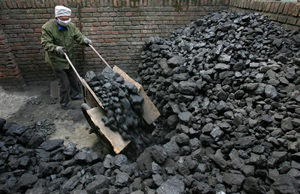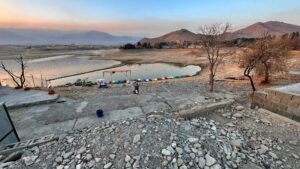Obama’s Plan to Save the World
Forget about terrorism for a moment. The potential catastrophe that climate change could unleash on America makes every other national security crisis pale in comparison. President Obama cannot secure the homeland without addressing this global emergency.
While pundits and politicians wrestle with immediate issues such as the economic meltdown, the wars in Iraq and Afghanistan and the nuclear ambitions of Iran and North Korea, global climate change has emerged as one of the most critical and contentious security issues of the 21st century. The new director of national intelligence, Adm. Dennis Blair, has cited rising temperatures, combined with an increase in weather-related natural disasters, as a major facilitator of governmental instability worldwide, especially in underdeveloped regions. Issues of poverty, infrastructure degradation, social and political collapse and environmental decay will all be exacerbated by global warming. While the crises stemming from climate change will initially manifest themselves most critically in regions of the world already impacted by political, social and economic turmoil, there is a pronounced threat of spillover as entire populations migrate from the stricken regions into areas where humans have a better chance of survival. The severity and longevity of the consequences of severe weather-related events will make current mechanisms of containing and mitigating these crises inadequate. The scope and scale of these massive migrations would be unprecedented in modern history, as would the ensuing conflicts over basic resources such as food and water, not to mention energy.
The potential catastrophe that global climate change could unleash on America makes every other foreign policy crisis pale in comparison. Recognizing the importance of proactive, as opposed to reactive, policy to head off these looming problems, President Obama has crafted a national policy designed to address the principal underlying cause of global climate change: greenhouse gas emissions. Greenhouse gas reduction is one of three pillars on which Obama has constructed his ambitious energy plan, the other two being economic stimulus and increased energy security. In the recent economic stimulus bill signed by the president, some $50 billion of a $789 billion total stimulus package will be set aside for programs related to efficient and renewable energy. This will be followed by an outlay of $150 billion over 10 years for investments in projects related to clean energy, efficient power generation and usage, and improved domestic oil and gas production.
Increased domestic energy production is linked with a broader concept of increased energy security, the stated objectives of which are to reduce American dependency on imported oil from the Middle East and Venezuela, which together account for 33 percent of the United States’ daily consumption, 10 million barrels. Reducing or eliminating this dependency is seen as a mechanism for freeing up American diplomatic and economic options in these critical regions, providing U.S. leaders with more flexibility in crafting solutions deemed to be in the national interest, and not so heavily tied to the need to guarantee continued access to these important sources of energy. But increased domestic energy production will not, in and of itself, deal with the pressing issue of greenhouse gas emissions. Indeed, void of a plan to manage greenhouse gas emissions, any massive effort to increase domestic energy production could result in even higher emissions.
The Obama administration does have a plan, in the form of an innovative, ambitious and as such contentious national “cap and trade” system for managing and reducing greenhouse gas emissions. Under the plan, the government would establish a national standard for greenhouse gas emissions by various industries, representing a “cap” intended to achieve a reduction of 80 percent by 2050. Industries operating below this “cap” would have “credits” that could then be traded — through for-profit “auctions” — to industries unable to meet the standard.
The Obama administration believes this cap-and-trade proposal will not only reduce greenhouse gas emissions in the United States but will also generate federal income from the taxation of the revenue obtained from the trading of credits. This revenue would then be invested by the government in new clean energy projects and initiatives. There is even an international aspect of the domestic cap-and-trade system: Heavy U.S. emitters of greenhouse gases would have the option of offsetting their domestic quotas by investing in low-carbon energy projects in the developing world. There are several major obstacles in the way of turning the cap-and-trade concept into reality. First, there is the issue of establishing a domestic framework for defining and enforcing the greenhouse emission caps. The industrial infrastructure that would be most impacted by the caps is arguing for a single national standard, as opposed to caps being set at the state level. Another key issue is the cap itself, how it would be defined, and what benchmarks would be set for implementation of the 80 percent reduction. Until these questions are answered, new energy production initiatives in the United States are frozen.
Second, there is a need to integrate the ambitious American domestic policy into an overarching international policy of controlling greenhouse gas emissions. President Obama has committed to the creation of a Global Energy Forum, which would comprise the core G-8 countries plus major developing nations such as Brazil, China, India, Mexico and South Africa. The forum would focus exclusively on global energy and environmental issues. Obama has also committed to re-engage the United States in the United Nations Framework Convention of Climate Change (UNFCCC), which is working to build a new global regime of commitments to replace the existing Kyoto Protocol, which expires in 2012.The goals and expectations that individual nations bring to these assemblies, whether it is Obama’s Global Energy Forum or the UNFCCC, differ greatly. As a developed nation, the United States has flexibility in internal operations that nations conducting major development programs, such as China and India, do not. Negotiating viable greenhouse emissions caps with China, India and other major developing nations is essential to defining a realistic emission cap in the United States. Without such a global agreement, U.S. industries may be compelled, because of simple economics, to flee a constrictive American domestic environment for more permissive locations abroad. Such flight would be counterproductive to the Obama economic stimulus plan, which hinges on industries, and their associated jobs, remaining in the U.S. It would also hamper the overall goal of reducing global emissions to make the homeland more secure.
Another problem is the issue of projecting caps in a fair and equitable manner. While the United States and Europe can project with some confidence energy consumption models for the foreseeable future, the same cannot be said of many developing nations. A cap level for the U.S. and Europe projected over a 50-year period is viable. However, for developing nations, population changes alone will radically alter their energy consumption requirements, as well as their population-related infrastructures. Caps using present-day criteria would rapidly become unrealistic, and consequently would be subject to violation. However, adjusting U.S. and European caps based upon such projections would place an even greater burden on the industrial bases of these nations. Managing the issue would be a major challenge for the Obama administration and the rest of the world.
The linkage between global climate change, national security and energy consumption models is not one of normal association. Today, however, the potential impact on global social, political and economic systems simply cannot be ignored. This impact would be not only iterative, but would cumulatively have an effect that is several orders of magnitude greater than what normally would be projected. Preventing, or at least containing and mitigating, the potential dire consequences of global climate change will require sweeping reform which will affect existing global energy consumption models. How this reform is framed, and the manner in which it is implemented, will likewise heavily influence the economic, political and physical aspects of the world energy markets, making global climate change perhaps the most critical issue when it comes to the future of energy security, and national security.
Given the paramount role played by the United States in world affairs today, the energy policies implemented by the Obama administration will have an influence unmatched by any other nation or group of nations. While the Obama energy plan is complex, a major indicator of whether or not the plan is unfolding as expected will be the issue of cap and trade. The success or failure of the cap-and-trade initiative will impact the overall viability of Obama’s clean energy initiatives, domestically and internationally, and as such should be closely monitored by all parties with a vested interest in energy and related security matters. And given the inherent problems confronting the successful implementation of the cap-and-trade initiative, it is imperative that the Obama administration develop alternative plans and courses of action. There might not be enough time to do so if “cap and trade” fails.
The threats faced by America and the rest of the world today from terrorism and so-called rogue states will shrink into insignificance if entire populations begin vying for habitable land and the basic resources required to sustain life. This is a predictable problem, with recognizable solutions. Whether America and the world have the collective wisdom, and courage, to implement these solutions is yet to be seen.
|
Scott Ritter is a former intelligence and arms control official who was an inspector in the former Soviet Union (1988-1990) and Iraq (1991-1998). He is the author of “Target Iran” (Nation Books, 2007) and the forthcoming “On Dangerous Ground: Following the Path of America’s Failed Arms Control Policy” (Nation Books). |
Independent journalism is under threat and overshadowed by heavily funded mainstream media.
You can help level the playing field. Become a member.
Your tax-deductible contribution keeps us digging beneath the headlines to give you thought-provoking, investigative reporting and analysis that unearths what's really happening- without compromise.
Give today to support our courageous, independent journalists.






You need to be a supporter to comment.
There are currently no responses to this article.
Be the first to respond.